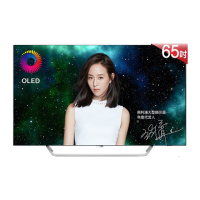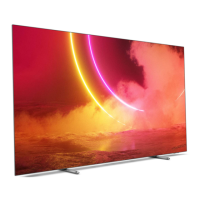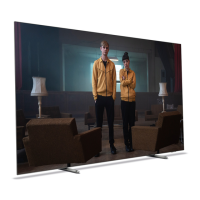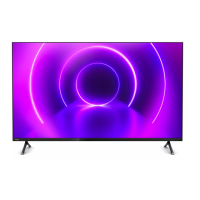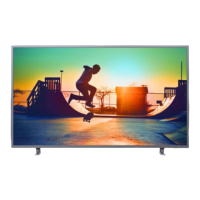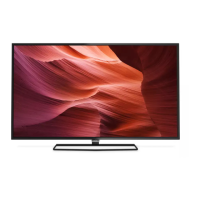Do you have a question about the Philips 55OLED754 and is the answer not in the manual?
Locate your TV's model and serial number for support and register your TV for benefits.
Access TV help functions for diagnosis, troubleshooting, and user manual information.
Find online support, FAQs, and download manuals or software from the Philips website.
Contact Consumer Care for support and repair services for your TV.
Learn how to update TV software via Internet or USB for the latest features and fixes.
Instructions to pair your Bluetooth remote control with the TV for full functionality.
Important safety instructions to read before using the TV for safe operation.
Guide to installing channels via Antenna/Cable, including search and reinstallation options.
How to open, navigate, tune to programmes, set reminders, and search by genre in the TV Guide.
How to record digital TV broadcasts, including manual and scheduled recordings.
Instructions for pausing and resuming live TV broadcasts using a connected USB Hard Drive.
Accessing frequently used settings and the comprehensive 'All settings' menu.
Access to all TV settings menus, including picture, sound, and network configurations.
Adjust and store custom picture settings for Colour, Contrast, Sharpness, and Brightness.
Advanced picture adjustments including Colour enhancement, gamut, and contrast modes.
Adjust auto volume, delta volume, digital output settings, and volume control.
Set parental ratings and app locks using a PIN code to restrict content access.
Connect your TV to a home network via wired or wireless connection for full capabilities.
Instructions for wireless and wired connections, including WPS methods.
View network settings, configure static IP, and manage Wi-Fi, Miracast, and network names.
Initial setup for Smart TV, including connection configuration and terms agreement.
Customize Ambilight effects by following video, audio, colour, or flag styles.
Adjust the brightness and saturation levels of the Ambilight lighting for desired effects.
Configure Philips Hue bulbs to sync with Ambilight for extended lighting effects.
Overview of Alexa voice control operations and requirements for using Alexa with your TV.
Step-by-step guide to set up and use Alexa voice control for your Philips Smart TV.
General troubleshooting tips, how to find solutions, and contact Philips support.
Troubleshooting steps if the TV does not switch on or responds unexpectedly.
Proper care for OLED screens, including display cleaning, refreshing processes, and avoiding image retention.
Essential safety precautions to prevent electric shock, fire, injury, overheating, and other hazards.
Guidelines for cleaning the TV screen and protecting it from damage, static images, and humidity.
Locate your TV's model and serial number for support and register your TV for benefits.
Access TV help functions for diagnosis, troubleshooting, and user manual information.
Find online support, FAQs, and download manuals or software from the Philips website.
Contact Consumer Care for support and repair services for your TV.
Learn how to update TV software via Internet or USB for the latest features and fixes.
Instructions to pair your Bluetooth remote control with the TV for full functionality.
Important safety instructions to read before using the TV for safe operation.
Guide to installing channels via Antenna/Cable, including search and reinstallation options.
How to open, navigate, tune to programmes, set reminders, and search by genre in the TV Guide.
How to record digital TV broadcasts, including manual and scheduled recordings.
Instructions for pausing and resuming live TV broadcasts using a connected USB Hard Drive.
Accessing frequently used settings and the comprehensive 'All settings' menu.
Access to all TV settings menus, including picture, sound, and network configurations.
Adjust and store custom picture settings for Colour, Contrast, Sharpness, and Brightness.
Advanced picture adjustments including Colour enhancement, gamut, and contrast modes.
Adjust auto volume, delta volume, digital output settings, and volume control.
Set parental ratings and app locks using a PIN code to restrict content access.
Connect your TV to a home network via wired or wireless connection for full capabilities.
Instructions for wireless and wired connections, including WPS methods.
View network settings, configure static IP, and manage Wi-Fi, Miracast, and network names.
Initial setup for Smart TV, including connection configuration and terms agreement.
Customize Ambilight effects by following video, audio, colour, or flag styles.
Adjust the brightness and saturation levels of the Ambilight lighting for desired effects.
Configure Philips Hue bulbs to sync with Ambilight for extended lighting effects.
Overview of Alexa voice control operations and requirements for using Alexa with your TV.
Step-by-step guide to set up and use Alexa voice control for your Philips Smart TV.
General troubleshooting tips, how to find solutions, and contact Philips support.
Troubleshooting steps if the TV does not switch on or responds unexpectedly.
Proper care for OLED screens, including display cleaning, refreshing processes, and avoiding image retention.
Essential safety precautions to prevent electric shock, fire, injury, overheating, and other hazards.
Guidelines for cleaning the TV screen and protecting it from damage, static images, and humidity.
| Screen shape | Flat |
|---|---|
| Response time | - ms |
| Display diagonal | 55 \ |
| Display brightness | - cd/m² |
| Display technology | OLED |
| Native aspect ratio | 16:9 |
| Native refresh rate | 60 Hz |
| Supported video modes | 2160p |
| Contrast ratio (typical) | - |
| Display diagonal (metric) | 139 cm |
| Screen format adjustments | 16:9, Zoom |
| Supported graphics resolutions | 3840 x 2160 |
| Motion interpolation technology | PPI (Picture Performance Index) 4500 |
| Color gamut | 99 % |
| Battery type | AAA |
| Google applications | YouTube |
| Ambient lighting type | 3-sided |
| Number of batteries supported | 2 |
| Processor cores | 4 |
| Teletext standards | Hyper-text |
| Audio formats supported | AAC, MP3, WAV, WMA, WMA-PRO |
| Image formats supported | BMP, GIF, HEIF, JPEG, PNG |
| Video formats supported | AVC, AVI, H.264, H.265, HEVC, MKV, MPEG1, MPEG2, MPEG4, VC-1, VP9, WMV9 |
| Subtitle formats supported | SMI, SRT, SUB, TXT |
| Picture processing technology | Philips Perfect Pixel Picture Engine |
| High Dynamic Range (HDR) technology | Hybrid Log-Gamma (HLG), Dolby Vision, High Dynamic Range 10 (HDR10) |
| Product color | Black |
| Heavy metals free | Hg (mercury) |
| Panel mounting interface | 300 x 300 mm |
| Wi-Fi standards | Wi-Fi 4 (802.11n) |
| Audio decoders | DTS, Dolby Atmos, Dolby Digital, DTS-HD |
| RMS rated power | 16 W |
| Equalizer bands quantity | 5 |
| Cables included | AC |
| Programming period | 8 day(s) |
| Firmware upgradeable via | Network, USB |
| Tuner type | Analog & digital |
| Analog signal format system | NTSC, PAL, SECAM |
| Digital signal format system | DVB-C, DVB-S, DVB-S2, DVB-T, DVB-T2, DVB-T2 HD |
| USB 2.0 ports quantity | USB 2.0 ports have a data transmission speed of 480 Mbps, and are backwards compatible with USB 1.1 ports. You can connect all kinds of peripheral devices to them. |
| Ethernet LAN (RJ-45) ports | 1 |
| Consumer Electronics Control (CEC) | EasyLink |
| AC input voltage | 220 - 240 V |
| AC input frequency | 50 - 60 Hz |
| Energy efficiency scale | A to G |
| Power consumption (standby) | 0.3 W |
| Power consumption (typical) | 140 W |
| Operating temperature (T-T) | 5 - 35 °C |
| Package type | Box |
| Package depth | 174 mm |
| Package width | 1400 mm |
| Package height | 867 mm |
| Package weight | 25800 g |
| Stand width | 789 mm |
|---|---|
| Stand height | 11 mm |
| Depth (with stand) | 230 mm |
| Height (with stand) | 716.6 mm |
| Weight (with stand) | 21500 g |
| Depth (without stand) | 49.3 mm |
| Width (without stand) | 1227.8 mm |
| Height (without stand) | 705.6 mm |
| Weight (without stand) | 21200 g |


